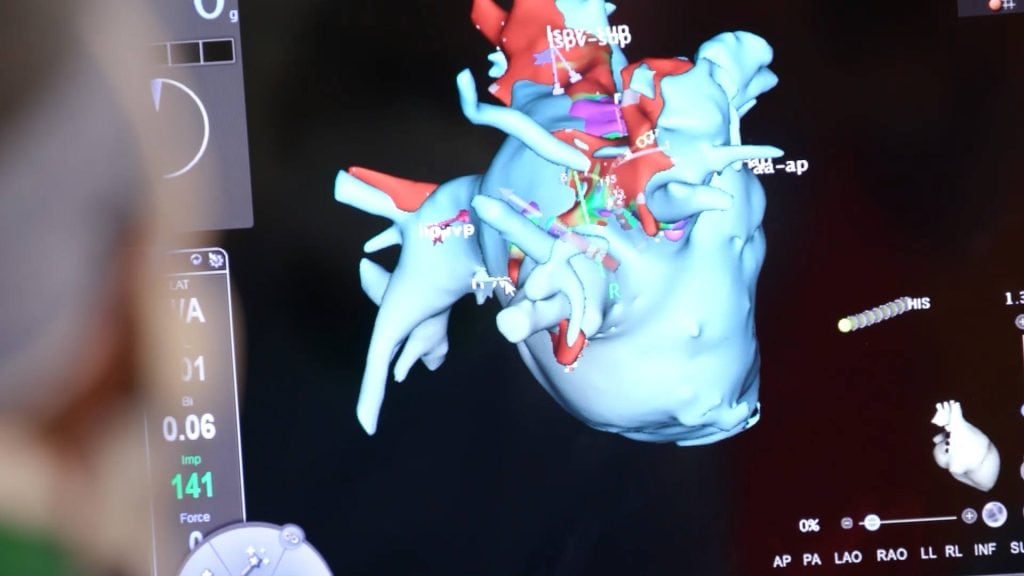Diagnosis
Cardiogenic shock is usually diagnosed in an emergency setting. Doctors will check for signs and symptoms of shock, and will then perform tests to find the cause. Tests might include:
- Blood pressure measurement. People in shock have very low blood pressure.
- Electrocardiogram (ECG or EKG). This quick, noninvasive test records the electrical activity of your heart using electrodes attached to your skin. If you have damaged heart muscle or fluid buildup around your heart, the heart won't send electrical signals normally.
- Chest X-ray. A chest X-ray shows the size and shape of your heart and whether there's fluid in your lungs.
- Blood tests. You'll have blood drawn to check for organ damage, infection and heart attack. An arterial blood gas test might be done to measure oxygen in your blood.
- Echocardiogram. Sound waves produce an image of your heart. This test can help identify damage from a heart attack.
- Cardiac catheterization (angiogram). This test can reveal blocked or narrowed arteries. A doctor inserts a long, thin tube (catheter) through an artery in your leg or wrist and guides it to your heart. Dye flows through the catheter, making your arteries more easily seen on X-ray.
Treatment
Cardiogenic shock treatment focuses on reducing the damage from lack of oxygen to your heart muscle and other organs.
Emergency life support
Most people who have cardiogenic shock need extra oxygen. If necessary, you'll be connected to a breathing machine (ventilator). You'll receive medications and fluid through an IV line in your arm.
Medications
Fluids and plasma are given through an IV. Medications to treat cardiogenic shock are given to increase your heart's pumping ability and reduce the risk of blood clots.
- Vasopressors. These medications are used to treat low blood pressure. They include dopamine, epinephrine (Adrenaline, Auvi-Q), norepinephrine (Levophed) and others.
- Inotropic agents. These medications, which help improve the pumping function of the heart, may be given until other treatments start to work. They include dobutamine, dopamine and milrinone.
- Aspirin. Aspirin is usually given immediately to reduce blood clotting and keep blood moving through a narrowed artery. Take an aspirin yourself while waiting for help to arrive only if your doctor has previously told you to do so for symptoms of a heart attack.
- Antiplatelet medication. Emergency room doctors might give you drugs similar to aspirin to help prevent new clots from forming. These medications include clopidogrel (Plavix), tirofiban (Aggrastat) and eptifibatide (Integrilin).
- Other blood-thinning medications. You'll likely be given other medications, such as heparin, to make your blood less likely to form clots. IV or injectable heparin usually is given during the first few days after a heart attack.
Surgeries and other procedures
Medical procedures to treat cardiogenic shock usually focus on restoring blood flow through your heart. They include:
-
Angioplasty and stenting. If a blockage is found during a cardiac catheterization, your doctor can insert a long, thin tube (catheter) equipped with a special balloon through an artery, usually in your leg, to a blocked artery in your heart. Once in position, the balloon is briefly inflated to open the blockage.
A metal mesh stent might be inserted into the artery to keep it open over time. In most cases, you doctor will place a stent coated with a slow-releasing medication to help keep your artery open.
- Balloon pump. Your doctor inserts a balloon pump in the main artery off of your heart (aorta). The pump inflates and deflates within the aorta, helping blood flow and taking some of the workload off your heart.
- Extracorporeal membrane oxygenation (ECMO). extracorporeal membrane oxygenation (ECMQ) helps improve blood flow and supplies oxygen to the body. Blood is pumped outside of your body to a heart-lung machine that removes carbon dioxide and sends oxygen-filled blood back to tissues in the body.
If medications and other procedures don't work to treat cardiogenic shock, your doctor might recommend surgery.
- Coronary artery bypass surgery. This surgery uses a healthy blood vessel in your leg, arm or chest to create a new pathway for blood so it can flow around a blocked or narrowed artery. Your doctor might suggest this surgery after your heart has had time to recover from your heart attack. Occasionally, bypass surgery is done as an emergency treatment.
- Surgery to repair an injury to your heart. Sometimes an injury, such as a tear in one of your heart's chambers or a damaged heart valve, can cause cardiogenic shock. Surgery might correct the problem.
- Ventricular assist device (VAD). A mechanical device can be implanted into the abdomen and attached to the heart to help it pump. A ventricular assist device (VAD) might extend and improve the lives of some people with end-stage heart failure who are waiting for new hearts or aren't able to have a heart transplant.
- Heart transplant. If your heart is so damaged that no other treatments work, a heart transplant may be a last resort.

